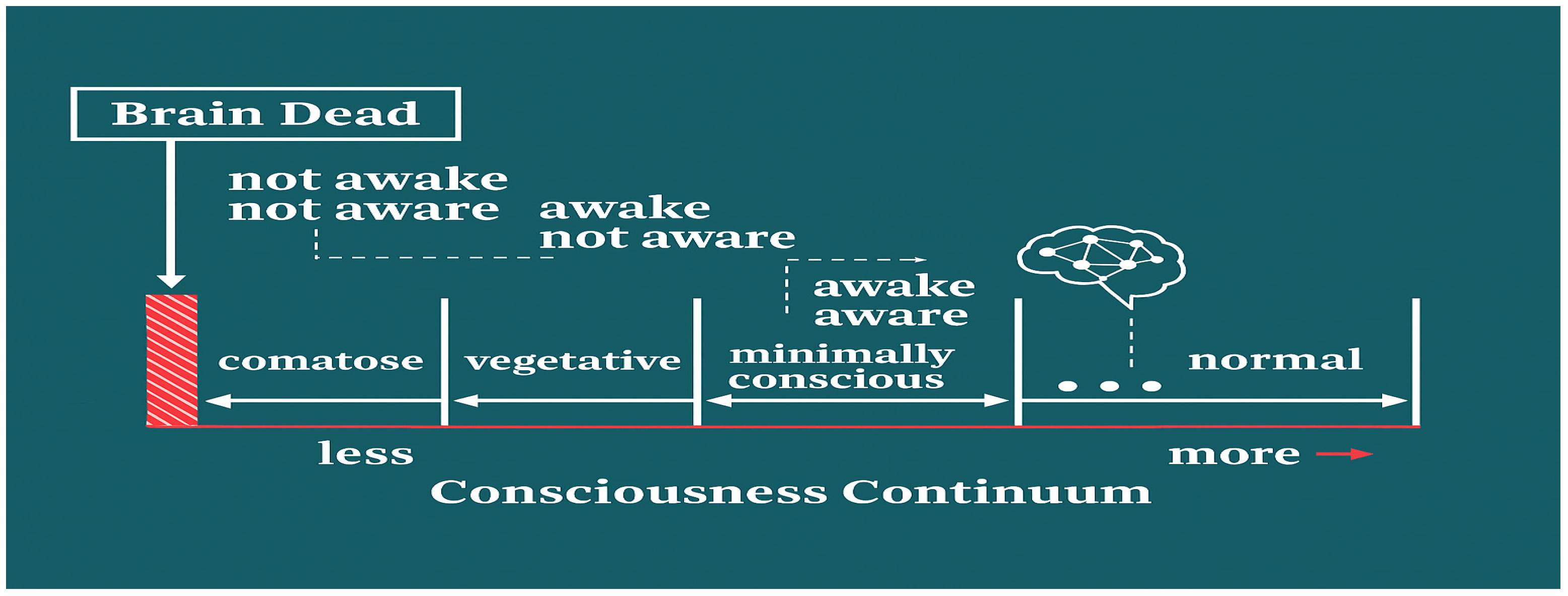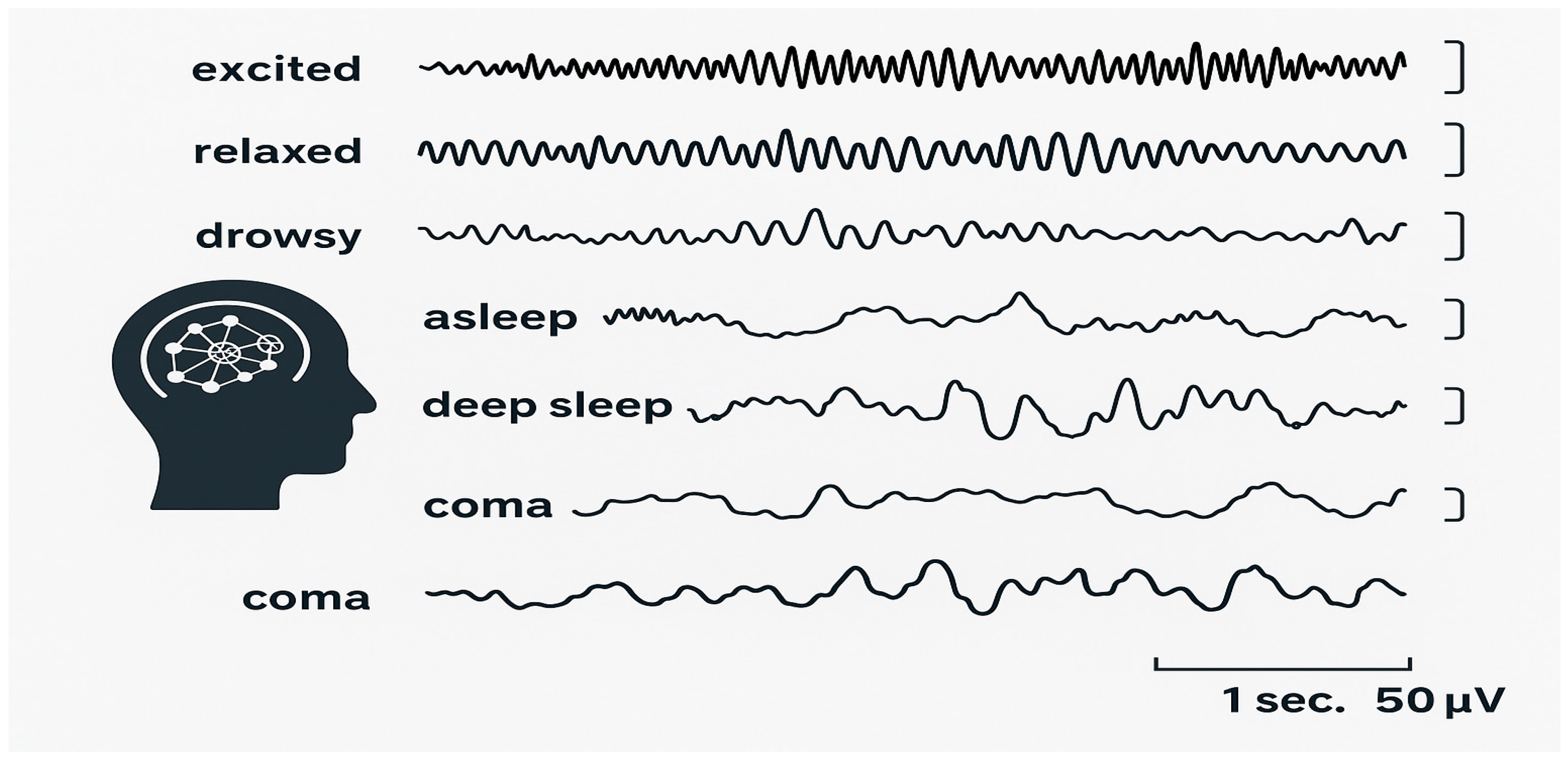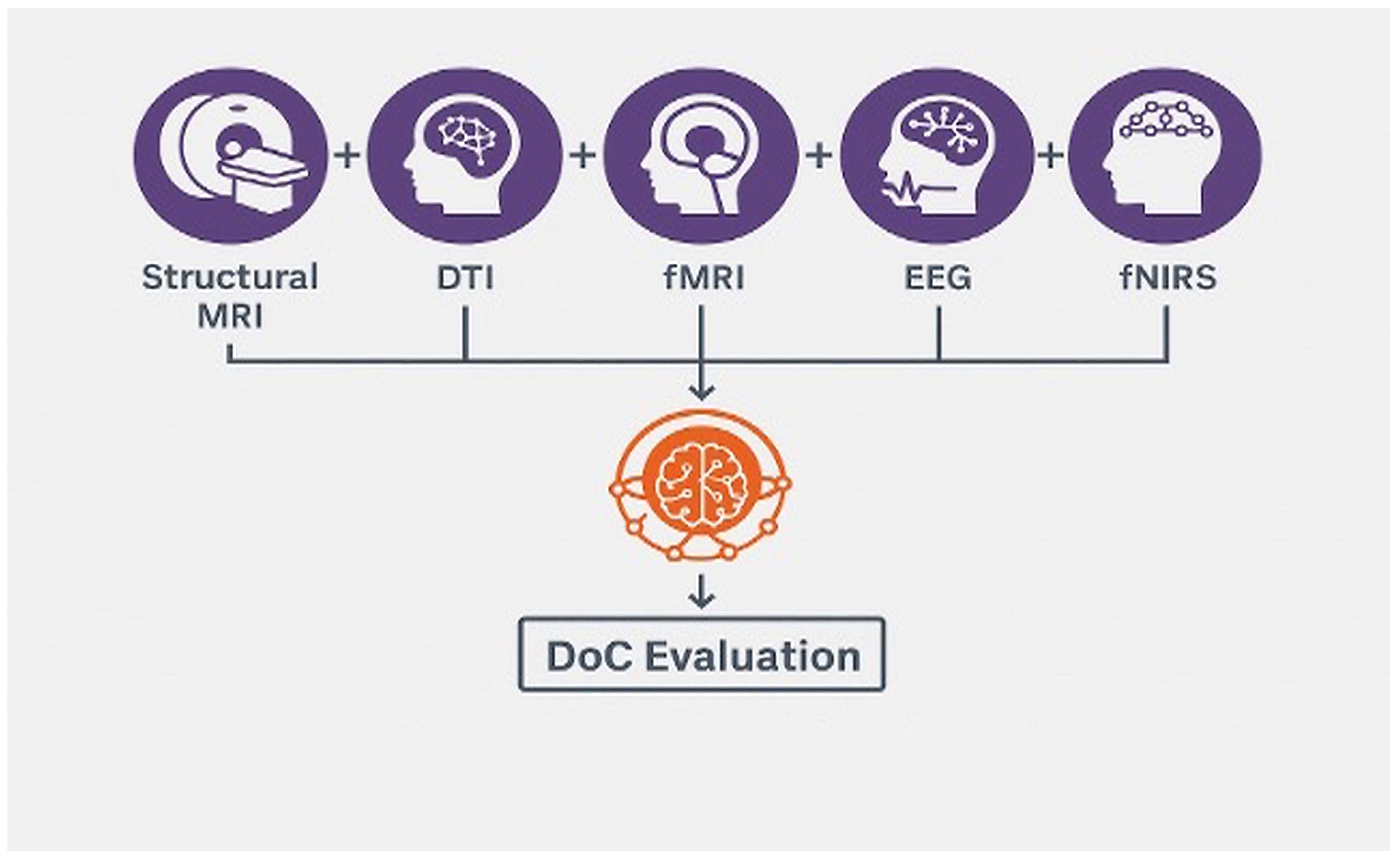The Spectrum of Consciousness on the Borders of Life and Death
Abstract
1. Introduction
Lack of a Scientific Conceptualization of Death and Cessation of Consciousness
2. Life, Death, and Consciousness Are Not Binary
Attempting to Objectify the Complete Cessation of Consciousness at the Point of Death
3. Objectively Classifying Disorders of Consciousness
3.1. Coma
3.2. Vegetative State/Unresponsive Wakefulness Syndrome (VS/UWS)
3.3. Minimally Conscious State (MCS)
3.4. Locked-In Syndrome (LIS)
4. Neuroimaging to Study DoCs
4.1. Detecting Covert Consciousness
4.2. Prognostic Value of Neuroimaging
4.3. Clinical Integration and Challenges
4.4. Future Directions
5. Discussion
6. Conclusions
- Harmonize BD/DNC determination across institutions via consensus operational criteria, explicit documentation standards, and mandatory training/competency maintenance.
- Implement tiered, multimodal diagnostic pathways for disorders of consciousness (DoC) that integrate standardized behavioral scales with EEG/ERP and, when feasible, fMRI or fNIRS for covert responsiveness.
- Establish routine re-assessment schedules in prolonged DoC, with predefined triggers for escalating diagnostic depth (e.g., from EEG to fMRI).
- Create ethical decision frameworks for cases with covert consciousness, including communication aids, rehabilitation access, and transparent guidance for life-sustaining therapy deliberations.
- Build secure, prospective registries linking clinical phenotypes, imaging/electrophysiology, treatments, and outcomes to accelerate learning health–system cycles.
Author Contributions
Funding
Conflicts of Interest
Abbreviations
| BD | Brain Death |
| CMD | Cognitive Motor Dissociation |
| DNC | Death by Neurological Criteria |
| DTI | Diffusion Tensor Imaging |
| DMN | Default Mode Network |
| ECMO | Extracorporeal Membrane Oxygenation |
| EEG | Electroencephalography |
| fMRI | Functional Magnetic Resonance Imaging |
| fNIRS | Functional Near-Infrared Spectroscopy |
| DoC | Disorders of Consciousness |
| LIS | Locked-In Syndrome |
| MCS | Minimally Conscious State |
| MEG | Magnetoencephalography |
| UWS | Unresponsive Wakeful State |
| VS | Vegetative State |
References
- Leisman, G.; Koch, P. Networks of conscious experience: Computational neuroscience in understanding life, death, and consciousness. Rev. Neurosci. 2009, 20, 151–176. [Google Scholar] [CrossRef]
- Leisman, G.; Machado, C. Many paths to consciousness or just one? Life in a bounded continuum. J. Conscious. Stud. 2021, 28, 83–96. [Google Scholar]
- Greer, D.M.; Lewis, A.; Kirschen, M.P. New developments in guidelines for brain death/death by neurological criteria. Nat. Rev. Neurol. 2024, 20, 151–161. [Google Scholar] [CrossRef] [PubMed]
- Bernat, J.L. The brainstem criterion of death and accurate syndromic diagnosis. Am. J. Bioeth. 2024, 1, 103–106. [Google Scholar] [CrossRef]
- Bayne, T.; Seth, A.K.; Massimini, M.; Shepherd, J.; Cleeremans, A.; Fleming, S.M.; Malach, R.; Mattingley, J.B.; Menon, D.K.; Owen, A.M.; et al. Tests for consciousness in humans and beyond. Trends Cogn. Sci. 2024, 28, 454–466. [Google Scholar] [CrossRef]
- Golden, K.; Bodien, Y.G.; Giacino, J.T. Disorders of consciousness: Classification and taxonomy. Phys. Med. Rehabil. Clin. N. Am. 2024, 35, 15–33. [Google Scholar] [CrossRef]
- Machado, C. Comment on: Canadian clinical practice guideline on brain death. Can. J. Anaesth. 2023, 70, 2013–2014. [Google Scholar] [CrossRef]
- Lewis, A. The Uniform Determination of Death Act is being revised. Neurocrit. Care 2022, 36, 335–338. [Google Scholar] [CrossRef]
- Lewis, A. How can international consistency in determination of brain death/death by neurological criteria be improved? The World Brain Death Project. J. Neurosurg. Anesthesiol. 2023, 35, 169–171. [Google Scholar] [CrossRef]
- Johnson, L.S.M. Philosophical, Medical, and Legal Controversies About Brain Death; Cambridge University Press: Cambridge, UK, 2024. [Google Scholar]
- Lewis, A. Response to Machado RE: Revisions to the Uniform Determination of Death Act and other controversial aspects of the determination of death by neurologic criteria. Neurocrit. Care 2023, 38, 214–216. [Google Scholar] [CrossRef]
- Wijdicks, E.F.M. The historical trajectory of the apnea test in brain death determination. Neurocrit. Care 2024, 40, 364–366. [Google Scholar] [CrossRef]
- Laureys, S.; Celesia, G.G.; Cohadon, F.; Lavrijsen, J.; Leon-Carrion, J.; Sannita, W.G.; Sazbon, L.; Schmutzhard, E.; von Wild, K.R.; Zeman, A.; et al. Unresponsive wakefulness syndrome: A new name for the vegetative state or apallic syndrome. BMC Med. 2010, 8, 68. [Google Scholar] [CrossRef]
- van Erp, W.S.; Lavrijsen, J.C.; Vos, P.E.; Bor, H.; Laureys, S.; Koopmans, R.T. The vegetative state: Prevalence, misdiagnosis, and treatment limitations. J. Am. Med. Dir. Assoc. 2015, 16, 85.e9–85.e14. [Google Scholar] [CrossRef] [PubMed]
- Richter, T.; Nestler-Parr, S.; Babela, R.; Khan, Z.M.; Tesoro, T.; Molsen, E.; Hughes, D.A.; ISPOR Rare Disease Special Interest Group. Rare disease terminology and definitions—A systematic global review: Report of the ISPOR Rare Disease Special Interest Group. Value Health 2015, 18, 906–914. [Google Scholar] [CrossRef] [PubMed]
- Goldblatt Hyatt, E.; Wilpers, A.; Bahtiyar, M.O.; Hu, Y.; Leon-Martinez, D.; Chervenak, F.A.; McCoyd, J.L.M. “I don’t have a telephone to the fetus”: Clinicians’ conceptions of fetal patienthood in maternal-fetal surgery counseling. Soc. Sci. Med. 2024, 342, 116525. [Google Scholar] [CrossRef] [PubMed]
- Carton-Leclercq, A.; Carrion-Falgarona, S.; Baudin, P.; Lemaire, P.; Lecas, S.; Topilko, T.; Charpier, S.; Mahon, S. Laminar organization of neocortical activities during systemic anoxia. Neurobiol. Dis. 2023, 188, 106345. [Google Scholar] [CrossRef]
- Charpier, S. Between life and death: The brain twilight zones. Front. Neurosci. 2023, 17, 1156368. [Google Scholar] [CrossRef]
- Borjigin, J.; Lee, U.; Liu, T.; Pal, D.; Huff, S.; Klarr, D.; Sloboda, J.; Hernandez, J.; Wang, M.M.; Mashour, G.A. Surge of neurophysiological coherence and connectivity in the dying brain. Proc. Natl. Acad. Sci. USA 2013, 110, 14432–14437. [Google Scholar] [CrossRef]
- Borjigin, J.; Wang, M.M.; Mashour, G.A. Reply to Greyson et al.: Experimental evidence lays a foundation for a rational understanding of near-death experiences. Proc. Natl. Acad. Sci. USA 2013, 110, E4406. [Google Scholar] [CrossRef]
- Schramm, A.E.; Carton-Leclercq, A.; Diallo, S.; Navarro, V.; Chavez, M.; Mahon, S.; Charpier, S. Identifying neuronal correlates of dying and resuscitation in a model of reversible brain anoxia. Prog. Neurobiol. 2020, 185, 101733. [Google Scholar] [CrossRef]
- Sarton, B.; Tauber, C.; Fridman, E.; Peran, P.; Riu, B.; Vinour, H.; David, A.; Geeraerts, T.; Bounes, F.; Minville, V.; et al. Neuroimmune activation is associated with neurological outcome in anoxic and traumatic coma. Brain 2024, 147, 1213–1228. [Google Scholar] [CrossRef]
- Zhang, Q.; Lu, H.; Wang, J.; Yang, T.; Bi, W.; Zeng, Y.; Yu, B. Hierarchical rhythmic propagation of corticothalamic interactions for consciousness: A computational study. Comput. Biol. Med. 2024, 169, 107843. [Google Scholar] [CrossRef]
- Lawrence, M.M.; Ramirez, R.P.; Bauer, P.J. Communicating with unconscious patients: An overview. Dimens. Crit. Care Nurs. 2023, 42, 3–11. [Google Scholar] [CrossRef] [PubMed]
- Slomine, B.S.; Suskauer, S.J. Disorders of consciousness in children: Assessment, treatment, and prognosis. Phys. Med. Rehabil. Clin. N. Am. 2024, 35, 223–234. [Google Scholar] [CrossRef] [PubMed]
- Thibaut, A.; Bodien, Y.G.; Laureys, S.; Giacino, J.T. Minimally conscious state “plus”: Diagnostic criteria and relation to functional recovery. J. Neurol. 2019, 266, 936–944. [Google Scholar]
- Farisco, M.; Formisano, R.; Gosseries, O.; Kato, Y.; Koboyashi, S.; Laureys, S.; Lejeune, N.; Martial, C.; Matar, A.; Morrisey, A.M.; et al. International survey on the implementation of the European and American guidelines on disorders of consciousness. J. Neurol. 2024, 271, 395–407. [Google Scholar] [CrossRef]
- Machado, C.; Rodriguez-Rojas, R.; Leisman, G. Partial recovery of vegetative state after a massive ischaemic stroke in a child with sickle cell anaemia. BMJ Case Rep. 2020, 13, e235370. [Google Scholar] [CrossRef]
- Schnetzer, L.; McCoy, M.; Bergmann, J.; Kunz, A.; Leis, S.; Trinka, E. Locked-in syndrome revisited. Ther. Adv. Neurol. Disord. 2023, 16, 17562864231160873. [Google Scholar] [CrossRef]
- Xu, L.B.; Hampton, S.; Fischer, D. Neuroimaging in disorders of consciousness and recovery. Phys. Med. Rehabil. Clin. N. Am. 2024, 35, 51–64. [Google Scholar] [CrossRef]
- Nanni-Zepeda, M.; Degutis, J.; Wu, C.; Rothlein, D.; Fan, Y.; Grimm, S.; Walter, M.; Esterman, M.; Zuberer, A. Neural signatures of shared subjective affective engagement and disengagement during movie viewing. Hum. Brain Mapp. 2024, 45, e26622. [Google Scholar] [CrossRef]
- Wang, J.; Lai, Q.; Han, J.; Qin, P.; Wu, H. Neuroimaging biomarkers for the diagnosis and prognosis of patients with disorders of consciousness. Brain Res. 2024, 1803, 149133. [Google Scholar] [CrossRef]
- Tangonan, R.; Lazaridis, C. Evaluation and management of disorders of consciousness in the acute care setting. Phys. Med. Rehabil. Clin. N. Am. 2024, 35, 79–92. [Google Scholar] [CrossRef] [PubMed]
- Christensen, R.; De Vries, L.S.; Cizmeci, M.N. Neuroimaging to guide neuroprognostication in the neonatal intensive care unit. Curr. Opin. Pediatr. 2024, 36, 190–197. [Google Scholar] [CrossRef] [PubMed]
- Agarwal, Y.; Rameshkumar, R.; Krishnamurthy, S.; Senthilkumar, G.P. Incidence, risk factors, the role of plasma NGAL and outcome of contrast-induced acute kidney injury in critically ill children. Indian J. Pediatr. 2021, 88, 34–40. [Google Scholar] [CrossRef] [PubMed]
- Geisinger, R.; Rios, D.R.; McNamara, P.J.; Levy, P.T. Asphyxia, therapeutic hypothermia, and pulmonary hypertension. Clin. Perinatol. 2024, 51, 127–149. [Google Scholar] [CrossRef]
- Pastuszko, P.; Katz, M.G.; Ebel, T.; Bozek, V.; Kubin, L.; Kubin, J. Hypoxia-induced piglet model of cardiac arrest with assisted resuscitation by extracorporeal membrane oxygenation. Methods Mol. Biol. 2024, 2803, 227–237. [Google Scholar]
- Omairi, A.M.; Pandey, S. Targeted temperature management. In StatPearls; StatPearls Publishing: Treasure Island, FL, USA, 2023. [Google Scholar]
- Sanches, E.F.; Carvalho, A.S.; van de Looij, Y.; Toulotte, A.; Wyse, A.T.; Netto, C.A.; Sizonenko, S.V. Experimental cerebral palsy causes microstructural brain damage in areas associated to motor deficits but no spatial memory impairments in the developing rat. Brain Res. 2021, 1761, 147389. [Google Scholar] [CrossRef]
- Theodorou, C.M.; Galganski, L.A.; Jurkovich, G.J.; Farmer, D.L.; Hirose, S.; Stephenson, J.T.; Trappey, A.F. Causes of early mortality in pediatric trauma patients. J. Trauma Acute Care Surg. 2021, 91, 523–529. [Google Scholar] [CrossRef]
- Machado, C. Jahi McMath: A new state of disorder of consciousness. J. Neurosurg. Sci. 2021, 65, 211–213. [Google Scholar] [CrossRef]
- Machado, C. Brain death diagnosis in primary posterior fossa lesions. J. Neurosurg. Sci. 2022, 70, 670–675. [Google Scholar] [CrossRef]
- Machado, C. The Jahi McMath case: First detailed study of her brain. Neurol. India 2022, 70, 2235–2236. [Google Scholar] [CrossRef] [PubMed]
- Shewmon, D.A.; Salamon, N. The MRI of Jahi McMath and its implications for the global ischemic penumbra hypothesis. J. Child Neurol. 2022, 37, 35–42. [Google Scholar] [CrossRef] [PubMed]
- Toplutas, E.; Aydin, F.; Hanoglu, L. EEG microstate analysis in patients with disorders of consciousness and its clinical significance. Brain Topogr. 2024, 37, 377–387. [Google Scholar] [CrossRef] [PubMed]
- Bernat, J.L. The Uniform Law Commission and the conceptual basis for brain death: The UDDA revision series. Neurology 2024, 102, e209157. [Google Scholar] [CrossRef]
- Giacino, J.T.; Katz, D.I.; Schiff, N.D.; Whyte, J.; Ashman, E.J.; Ashwal, S.; Barbano, R.; Hammond, F.M.; Laureys, S.; Ling, G.S.F.; et al. Practice guideline update recommendations summary: Disorders of consciousness. Neurology 2018, 91, 450–460. [Google Scholar] [CrossRef]
- Kazazian, K.; Monti, M.M.; Owen, A.M. Functional neuroimaging in disorders of consciousness: Towards clinical implementation. Brain 2025, awaf075. [Google Scholar] [CrossRef]
- Hannawi, Y.; Yanek, L.R.; Kral, B.G.; Becker, L.C.; Vaidya, D.; Nyquist, P.A. Association of the brain white matter hyperintensity with the cognitive performance in middle-aged population. Cerebrovasc. Dis. 2024, 631–638. [Google Scholar] [CrossRef]
- DeMertzi, A.; Antonopoulos, G.; Heine, L.; Voss, H.U.; Crone, J.S.; de Los Angeles, C.; Bahri, M.A.; Di Perri, C.; Vanhaudenhuyse, A.; Charland-Verville, V.; et al. Intrinsic functional connectivity differentiates minimally conscious from unresponsive patients. Brain 2015, 138, 2619–2631. [Google Scholar] [CrossRef]
- Kondziella, D.; Bender, A.; Diserens, K.; van Erp, W.; Estraneo, A.; Formisano, R.; Laureys, S.; Naccache, L.; Ozturk, S.; Rohaut, B.; et al. European Academy of Neurology guideline on the diagnosis of coma and other disorders of consciousness. Eur. J. Neurol. 2020, 27, 741–756. [Google Scholar] [CrossRef]



| Clinical DoC Category | Clinical Definition and Criteria (Practical, Operational) | How Major Theories Interpret This State (Mechanistic, Explanatory) | Overlap and Divergence |
|---|---|---|---|
| Coma | No wakefulness (eyes closed), no awareness, no sleep–wake cycles. No purposeful responses; reflexes may be present. | - GNWT: No global broadcasting; brain activity remains in local, fragmented modules. - IIT: Very low Φ (integration measure) due to network disconnection. - RPT: No recurrent feedback processing to higher cortical areas. | Overlap: Both clinical and theoretical agree on near-total breakdown of large-scale network integration. Divergence: Theories try to quantify “zero consciousness,” clinicians simply categorize by absence of observable function. |
| Vegetative State/Unresponsive Wakefulness Syndrome (VS/UWS) | Wakefulness (eyes open, cycles present) without evidence of awareness. Preserved autonomic functions. | - GNWT: Sensory signals may reach cortex but fail to ignite global workspace. - IIT: Low Φ due to weak integration between sensory and associative areas. - RPT: Feedforward processing intact, but no feedback loops for awareness. | Overlap: Both agree on residual sensory processing without conscious report. Divergence: Theories speculate on minimal “phenomenal consciousness,” which is not captured in clinical diagnosis. |
| Minimally Conscious State (MCS) | Wakefulness with minimal but reproducible signs of awareness (e.g., following commands, visual tracking). | - GNWT: Occasional ignition of global workspace, but unstable due to network damage. - IIT: Fluctuating Φ reflecting partial but fragile integration. - RPT: Intermittent recurrent processing allowing sporadic conscious content. | Overlap: Both recognize partial preservation of conscious processing. Divergence: Theories focus on network dynamics explaining variability; clinicians rely on observed behaviors. |
| Locked-In Syndrome (LIS) | Fully conscious but unable to move/speak, except vertical eye movements/blinking. | - GNWT: Full global workspace function; motor output pathways disconnected. - IIT: Normal Φ and integration; bodily disconnection does not impair consciousness. - RPT: Normal recurrent processing; only motor execution affected. | Overlap: Both agree consciousness is intact. Divergence: Clinically, LIS can be confused with DoCs without careful testing; theories clarify that motor pathways are irrelevant to consciousness itself. |
| Cognitive Motor Dissociation (CMD) (covert consciousness) | No overt behavioral signs, but brain imaging/EEG shows willful modulation in response to commands. | - GNWT: Global workspace can ignite, but motor output pathways fail. - IIT: High Φ possible despite absent motor responses. - RPT: Preserved recurrent processing supports internal awareness. | Overlap: Both recognize hidden conscious processing. Divergence: Clinically this is a diagnostic challenge; theories predicted such states before clinical tools confirmed them. |
Disclaimer/Publisher’s Note: The statements, opinions and data contained in all publications are solely those of the individual author(s) and contributor(s) and not of MDPI and/or the editor(s). MDPI and/or the editor(s) disclaim responsibility for any injury to people or property resulting from any ideas, methods, instructions or products referred to in the content. |
© 2025 by the authors. Published by MDPI on behalf of the Swiss Federation of Clinical Neuro-Societies. Licensee MDPI, Basel, Switzerland. This article is an open access article distributed under the terms and conditions of the Creative Commons Attribution (CC BY) license (https://creativecommons.org/licenses/by/4.0/).
Share and Cite
Machado, C.; Leisman, G. The Spectrum of Consciousness on the Borders of Life and Death. Clin. Transl. Neurosci. 2025, 9, 48. https://doi.org/10.3390/ctn9040048
Machado C, Leisman G. The Spectrum of Consciousness on the Borders of Life and Death. Clinical and Translational Neuroscience. 2025; 9(4):48. https://doi.org/10.3390/ctn9040048
Chicago/Turabian StyleMachado, Calixto, and Gerry Leisman. 2025. "The Spectrum of Consciousness on the Borders of Life and Death" Clinical and Translational Neuroscience 9, no. 4: 48. https://doi.org/10.3390/ctn9040048
APA StyleMachado, C., & Leisman, G. (2025). The Spectrum of Consciousness on the Borders of Life and Death. Clinical and Translational Neuroscience, 9(4), 48. https://doi.org/10.3390/ctn9040048






